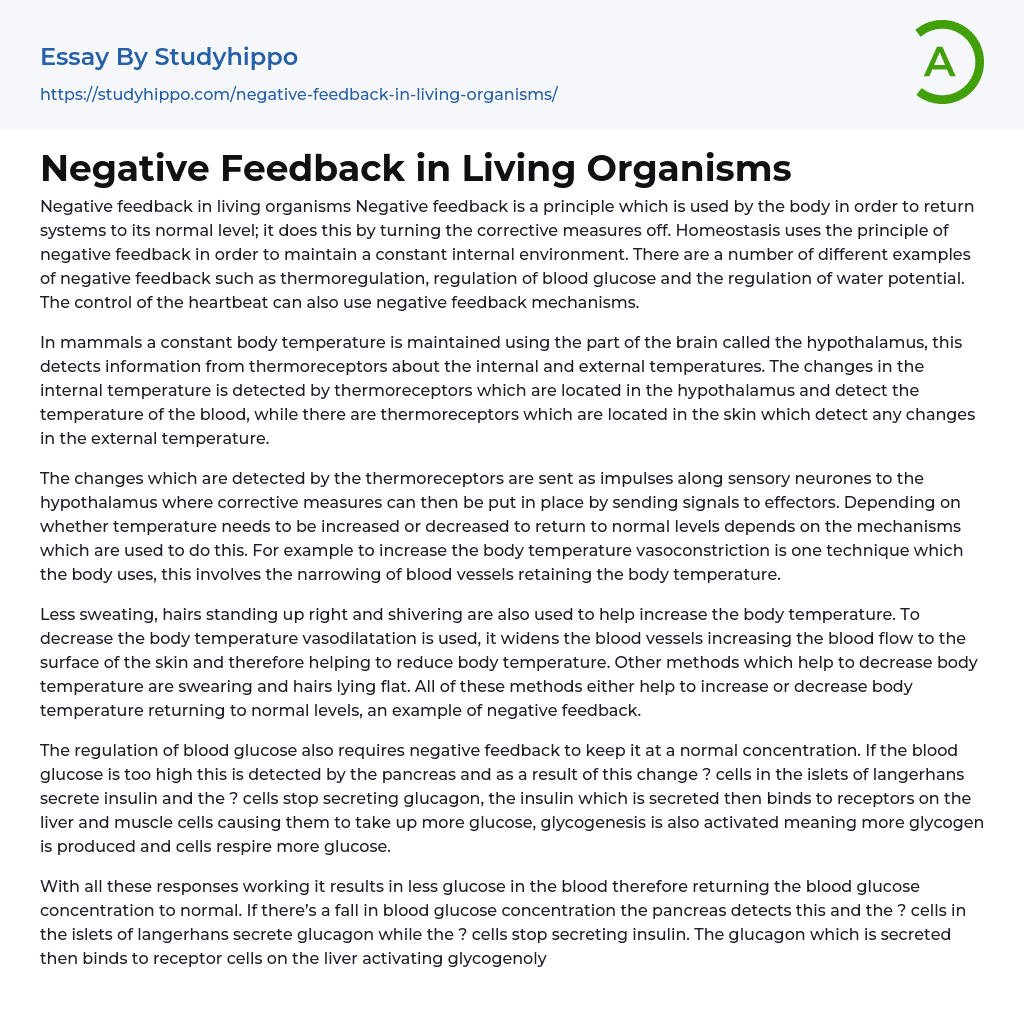Negative feedback in living organisms Negative feedback is a principle which is used by the body in order to return systems to its normal level; it does this by turning the corrective measures off. Homeostasis uses the principle of negative feedback in order to maintain a constant internal environment. There are a number of different examples of negative feedback such as thermoregulation, regulation of blood glucose and the regulation of water potential. The control of the heartbeat can also use negative feedback mechanisms.
In mammals a constant body temperature is maintained using the part of the brain called the hypothalamus, this detects information from thermoreceptors about the internal and external temperatures. The changes in the internal temperature is detected by thermoreceptors which are located in the hypothalamus and detect the temperature of the bl
...ood, while there are thermoreceptors which are located in the skin which detect any changes in the external temperature.
The changes which are detected by the thermoreceptors are sent as impulses along sensory neurones to the hypothalamus where corrective measures can then be put in place by sending signals to effectors. Depending on whether temperature needs to be increased or decreased to return to normal levels depends on the mechanisms which are used to do this. For example to increase the body temperature vasoconstriction is one technique which the body uses, this involves the narrowing of blood vessels retaining the body temperature.
Less sweating, hairs standing up right and shivering are also used to help increase the body temperature. To decrease the body temperature vasodilatation is used, it widens the blood vessels increasing the blood flow to
the surface of the skin and therefore helping to reduce body temperature. Other methods which help to decrease body temperature are swearing and hairs lying flat. All of these methods either help to increase or decrease body temperature returning to normal levels, an example of negative feedback.
The regulation of blood glucose also requires negative feedback to keep it at a normal concentration. If the blood glucose is too high this is detected by the pancreas and as a result of this change ? cells in the islets of langerhans secrete insulin and the ? cells stop secreting glucagon, the insulin which is secreted then binds to receptors on the liver and muscle cells causing them to take up more glucose, glycogenesis is also activated meaning more glycogen is produced and cells respire more glucose.
With all these responses working it results in less glucose in the blood therefore returning the blood glucose concentration to normal. If there’s a fall in blood glucose concentration the pancreas detects this and the ? cells in the islets of langerhans secrete glucagon while the ? cells stop secreting insulin. The glucagon which is secreted then binds to receptor cells on the liver activating glycogenolysis and gluconeogenesis.
With the process of glycogenolysis splitting any glycogen which has been produced therefore increasing the amount of glucose, cells also respire less glucose. This means the cells release glucose into the blood increasing the blood glucose concentration to normal levels. Control of the heart rate by chemoreceptors also uses a negative feedback mechanism. The chemoreceptors detect changes in the pH of the blood which result in changes in the
carbon dioxide concentration and then go about producing carbon dioxide to lower it back to its normal level.
When the chemoreceptors detect that the carbon dioxide concentration is higher than normal they increase the frequency of impulses to the medulla oblongata which increases the heart rate, this in turn then increases the frequency to the SAN which then increases the heart rate. As the heart rate has increases this increases the blood flow and means that more carbon dioxide is removed from the blood therefore returning the concentration to normal levels. This then allows the pH return to normal, the chemoreceptors detect this and the nerve impulses to the medulla oblongata are reduced and the heart rate returns to normal.
Another of example of negative feedback is the predator-prey relationship within a stable population. This happens as follow; predators eat their prey reducing the population of the prey, this means that there’s fewer prey available for the predators to eat resulting in more competition between the predators for the remaining food. This added competition reduces the population of the predators as they are no longer able to survive, as there’s fewer predators less prey are eaten allowing the population to begin to increase once again.
With more prey then available the predator population once again begins to increase. This example of negative feedback is particularly important in maintaining a stable population within ecosystems which are finely balanced. In conclusion negative feedback is important to maintain normal levels within the body’s internal environment allowing it to function efficiently. It is also important to maintain stable populations within ecosystems through the predator prey realtionship.
- Microbiology essays
- Bacteria essays
- Cell essays
- Enzyme essays
- Photosynthesis essays
- Plant essays
- Natural Selection essays
- Protein essays
- Viruses essays
- Cell Membrane essays
- Human essays
- Stem Cell essays
- Breeding essays
- Biotechnology essays
- Cystic Fibrosis essays
- Tree essays
- Seed essays
- Coronavirus essays
- Zika Virus essays
- Agriculture essays
- Albert einstein essays
- Animals essays
- Archaeology essays
- Bear essays
- Biology essays
- Birds essays
- Butterfly essays
- Cat essays
- Charles Darwin essays
- Chemistry essays
- Dinosaur essays
- Discovery essays
- Dolphin essays
- Elephant essays
- Eli Whitney essays
- Environmental Science essays
- Evolution essays
- Fish essays
- Genetics essays
- Horse essays
- Human Evolution essays
- Isaac Newton essays
- Journal essays
- Linguistics essays
- Lion essays
- Logic essays
- Mars essays
- Methodology essays
- Mineralogy essays
- Monkey essays




